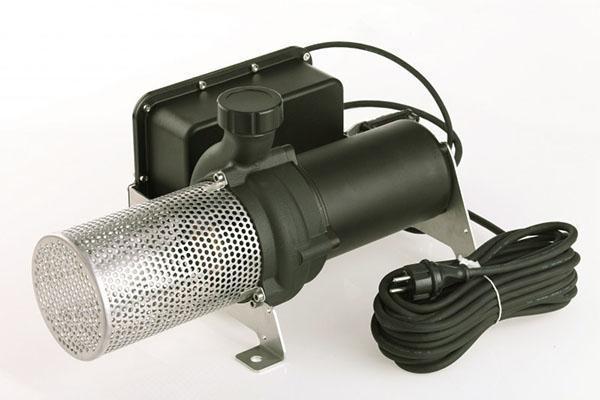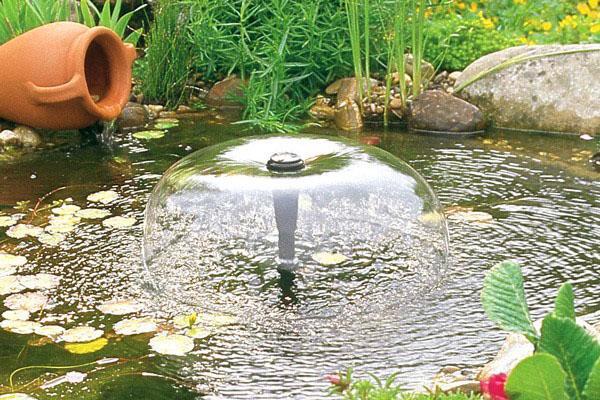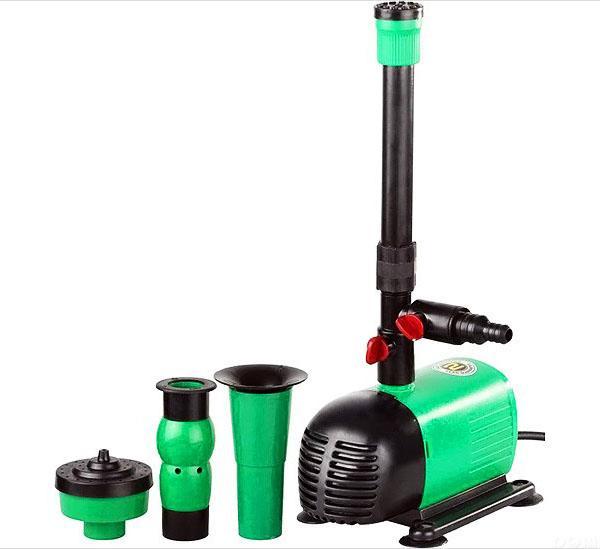Choosing a pump for a fountain in the country
 The view of the falling jets of water is mesmerizing, the murmur is soothing. To create an artificial waterfall in landscape or indoor design, you will need a fountain pump. For a cascade of water to delight with beauty, an accurate hydraulic engineering calculation of water circulation is required. The fountain is a decorative structure stylized as natural. Water jets emphasize beauty, bring coolness, play in the dark with skillful lighting.
The view of the falling jets of water is mesmerizing, the murmur is soothing. To create an artificial waterfall in landscape or indoor design, you will need a fountain pump. For a cascade of water to delight with beauty, an accurate hydraulic engineering calculation of water circulation is required. The fountain is a decorative structure stylized as natural. Water jets emphasize beauty, bring coolness, play in the dark with skillful lighting.
Variety of fountains

- The release of water upward or at an acute angle to the surface of the mirror is called a geyser. Depending on the performance and head power of the fountain pump, the water jets can rise several meters, forming a noisy rushing stream. A small indoor air humidifier, raising the fountain a few centimeters above the bowl installed on the nightstand, is also a geyser.
- If the water is raised low above the pool and drained through a nozzle, a beautiful transparent dome resembling a cap is created. Artificial lighting creates a flowing film overflow. Here, the exact calculation of the flow rate and head of the fountain pump plays a major role.
- Cascade - the view of calmly flowing water along the ledges and crevices of an artificial rocky slope brings coolness and peace. Water, accumulating in small lakes, overflows the region and continues to move downward. The jets of water wash away tension and negativity. In this composition, the pump for the fountain should be silent.
- Compositions connecting several points are called hybrid.
Outdoor fountains require water surface maintenance, sun protection, shutdown and conservation. Indoor structures are easier to manufacture and maintain.
Selection criteria for fountain pumps
 The delivery system consists of a pump, a pressure regulator and a nozzle that shapes and patterns the water cloud. The selection of fountain pumps is large. It is important to decide whether a submersible or surface apparatus will drive water through the system.
The delivery system consists of a pump, a pressure regulator and a nozzle that shapes and patterns the water cloud. The selection of fountain pumps is large. It is important to decide whether a submersible or surface apparatus will drive water through the system.
A surface pump is cheaper, but it will have to be installed on the shore of the water bowl. To avoid accidentally wetting the windings, for safety reasons, it needs to be stylized, creating a shelter from rain or splashes. This type of equipment works noisily, before starting it is necessary to fill the suction system with water. It is better if the suction hose has a filter mesh, and a check valve is installed on the nozzle. The air in the system is an obstacle to the water supply.
 Submersible pump for a fountain is installed in the water column. The engine and operating mechanism are in a sealed housing. The supply hose is hermetically pressed and sealed with epoxy glue. The submersible pump consumes less electricity while doing the same job. But he is not able to work constantly, the engine overheats. The device will need to be dismantled for service.
Submersible pump for a fountain is installed in the water column. The engine and operating mechanism are in a sealed housing. The supply hose is hermetically pressed and sealed with epoxy glue. The submersible pump consumes less electricity while doing the same job. But he is not able to work constantly, the engine overheats. The device will need to be dismantled for service.
For a submersible pump, an elevation must be created at the bottom. Otherwise, it will quickly clog up, tightening the bottom sediments.
The fountain pump is selected based on the calculation of the technical values of productivity and pressure presented in the table:
In the passport of any pump, the height, performance and power of the equipment are indicated. Low capacity pumps are suitable for creating home fountains. It is rational if the pump is equipped with:
- a transition pipe that increases the outlet pressure;
- a tee with a valve that allows you to distribute the water flow to two points;
- The LED head, which is used in the pump for the illuminated fountain, is mounted on a special threaded extension.
 The pumps that are considered to be fountains include Pondtech AP series, Messener ECO-X2.
The pumps that are considered to be fountains include Pondtech AP series, Messener ECO-X2.
Decorative lighting gives a fabulous play of light in the stream, surprises with the play of shadows in the pool. To create a light effect, halogen, LED lamps and fiber optics are used. Surface lighting is less dangerous, it is mounted using a 12/24 Volt network through a step-down transformer.
To ensure safety against electric shock, it is necessary to install an RCD in the lighting circuit - an automatic shutdown system.
Most often, a pump for the Sprut 1143 fountain is used in country landscape design.
The submersible pump Sprut 1143 is the smallest of the series. It works silently, compact, has 3 nozzles for different types of fountains. Pumps of the FSP, FST, FSS series of the Ukrainian manufacturer are designed for fountains and swimming pools.
Technical data and pump dimensions:
- productivity is 1 m3 / hour;
- head 1.6 m;
- power 22 W;
- pump height with nozzle 27 cm;
- case dimensions 10 * 8.5 * 8 cm.
 Pump fountain decorative has suction cups at the bottom, installed so that the suction opening is under the bay.
Pump fountain decorative has suction cups at the bottom, installed so that the suction opening is under the bay.
The pump will cost more, the greater the performance, the set of additional functions, the more famous the manufacturer.
You can make a pump for a fountain with your own hands. There are many options. Let's analyze the simplest one, which will raise the jet by 50 cm. For this, we use an electric motor from a room fan. Instead of an impeller, you will need to install a wheel by connecting it to the engine. For the pump, a casing with an intake and outlet is created, and the whole structure is hermetically sealed.
The baby pumps up to 50 liters of water per hour. The main thing is to make the connection points reliable and insulate the current-carrying wires well. Nozzles can be created from plastic bottles, or backlighting. The scope for imagination is unlimited.
 You can install a pump for a fountain with your own hands by using a drainage apparatus, laying a system of supply pipes, securing a nozzle. It is enough to fix the device on the bottom and equip it with a pressure regulating valve and a nozzle. It will be necessary to periodically stop the fountain to cool the pump and replace the intake filter.
You can install a pump for a fountain with your own hands by using a drainage apparatus, laying a system of supply pipes, securing a nozzle. It is enough to fix the device on the bottom and equip it with a pressure regulating valve and a nozzle. It will be necessary to periodically stop the fountain to cool the pump and replace the intake filter.
It is better to lay the power cable for all types of pumps in a protective casing, deepening into the ground.